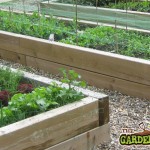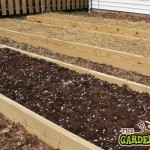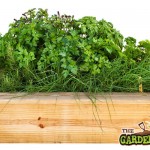There are endless reasons why raised beds are suitable for vegetable growing and garden plants in general. Not only do raised beds make general plant maintenance such as weeding, pruning and planting easier they also allow for better growing conditions for plants and vegetables.
- raised bed with netting
- Raised-Beds-with different soils
- Raised bed for Herbs
There are a range of plants, fruits and vegetables that prefer to grow in acidic soil conditions. Potato, broccoli, beetroot, onion, pea, lettuce are just some of the vegetables that prefer acidic conditions. In Ireland the majority of our soil is alkaline, this is due to our limestone parent rock and high calcium levels in the soil. Because of this we would need to alter the condition of our soil to provide the ideal growing conditions for these vegetables. Most fruits including blackberry, blueberry and most top fruits also require a slightly acidic soil.
Acidic soils develop naturally over time due to a number of factors including having acidic parent rock, heavy rainfall and leaching of calcium from the soil, the decay of organic material and intensive farming and use of nitrogen based fertilisers. However this process is quite slow and as gardeners there are a number of ways we can make our garden soil more acidic. By using raised beds we can quite easily change the condition of our soil
How to create acidic soil
The most important aspect of gardening and growing vegetables is good soil. With raised beds you can have the best and specific soil you need to grow your own herbs, fruit and vegetables.
When making a soil more acidic you are effectively decreasing its pH. The pH of a soil is the amount of Hydrogen Ions in the soil. The more Hydrogen Ions in the soil the more acidic it becomes. The pH scale ranges from 0 to 14.
0 – Acidic 7 – Neutral 14 – Alkaline
Most basic ways of increasing the acidity of your raised bed soil include:
- Adding Tea leaves to the soil
- Adding Peat moss to the soil
- Adding organic matter such as old leaves, composted greens, etc
- Placing old screws or nails into the base of the raised bed
Alternatively you can do one of the following
- Add ericaceous compost to the raised beds. Ericaceous compost is an acidic compost and can be bought in most garden centres. You would need to top up your beds every year with a new bag of compost
- Add Sulphur – Both a soil conditioner and acidifier. Sulphur helps to break down heavy soils improving drainage, while bacteria convert the sulphur into sulphuric acid. Apply 45 grams per square metre
- Add Ammonium Nitrate – This is a fertiliser that is high in Nitrogen and is commonly used in lawn feeds and sometimes used on it’s own as a lawn feed. The high Nitrogen levels will lead to an increase in acidic levels in soils. To increase acidity add 70 grams per square metre and rake in. This fertiliser will also encourage strong foliage growth
- Add Sulphate of Iron – This I a product found in most garden centres and is used to kill moss on lawns and hard surfaces. It is also sometimes used to increase acidity in soils and raised beds. Both Iron and Sulphur are acidic elements. Apply 35 grams per square metre over the surface of your raised bed and rake in. Water in after application and be sure to avoid direct contact with plant stems


